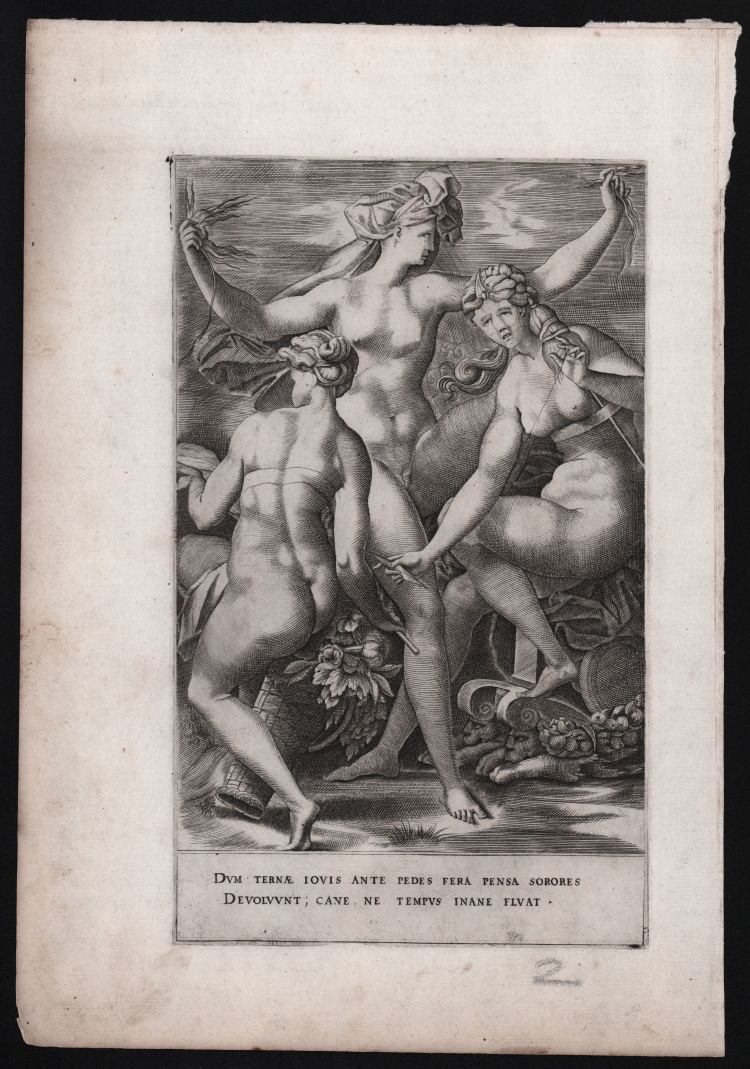





| Reference: | S48450 |
| Author | Anonimo |
| Year: | 1545 ca. |
| Measures: | 165 x 275 mm |




| Reference: | S48450 |
| Author | Anonimo |
| Year: | 1545 ca. |
| Measures: | 165 x 275 mm |
Engraving, 1540-45 circa, not signed.
After an engraving by Pierre Milan based on a drawing by Rosso Fiorentino.
This is an anonymous replica of the subject by an Italian or French engraver printed in Rome by the Lafreri printing house, as is also shown by the watermark on this specimen, the “tulips in shield with star” (Woodward nos. 124-125, dated from 1542 to 1570).
The scene depicts the three Fates: on the right, Lachesis spinning the thread of life from her distaff, on the left Clotho, seen from behind, measuring the thread with a rod, and in the middle, Atropos ripping it apart. Although this engraving is not inscribed to Rosso, his authorship of its composition has never been questioned. Dusmenil ascribed the engraved model to Renè Boyvin, because the Fate seen from the back is used for the female figure of “Caritas Romana”, attributed to him. According to the documents published by Metman, the Three Fates would have been engraved by Milan by 1545. Milan could have worked directly from a drawing by Rosso, or he could have worked from a copy of Rosso’s drawing made especially as a model for the engraver, as in the case of Milan’s Dance of the Dryads. Being young and nude as well as slender and graceful, these three figures have something of the aspect of the Three Graces, as Van Mander seems to have identified them. Other details in the picture may also be references to subjects beyond the usual realm of the Fates themselves. Atropo’s turban gives her a sibylic aspect. Clotho sits precariously upon a basket of flowers, suggesting Flora or Spring or simply abundance and freshness. Lachesis wears a crown, and her seat resembles a chariot pulled by lions. These attributes are possibly a reference to Cybele. The sky appears throughout Rosso’s art, especially in the works he produced in France, and they not seem inappropriate here in enlarging upon the meaning of the three Fates. The Three Fates offer a different level and a different range of significance. Its sexuality is frank but also compelling, because the figures are so grand and so eloquent in their posture and gestures. This eloquence insinuates their sexuality into their identity as the Fates and leads us to experience the tragic consequences indicates by Atropo’s gesture.
Magnificent proof, rich in tone, printed on contemporary laid paper with watermark “tulips in shield with star” (Woodward nos. 124-125), with wide margins, in perfect condition.
Beautiful specimen of this rare engraving.
Bibliografia
Zerner 1969 PM.2; Robert-Dumesnil 1835-71 VIII.33.31; Carroll, Rosso Fiorentino, n.105.
Anonimo
Anonimo